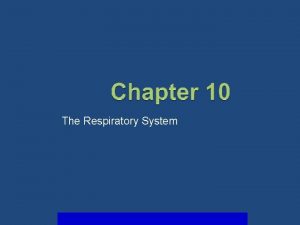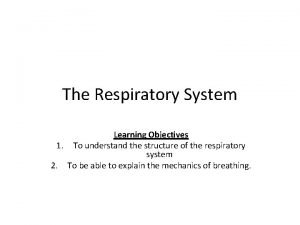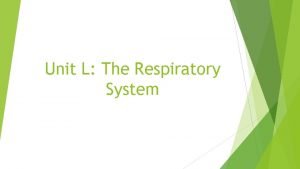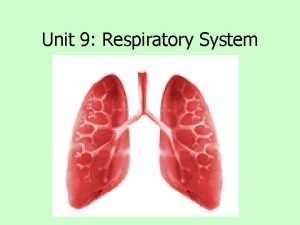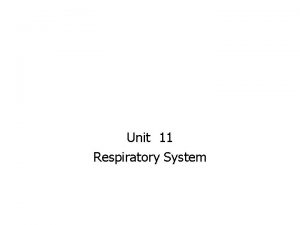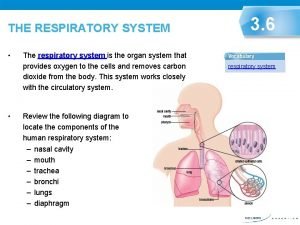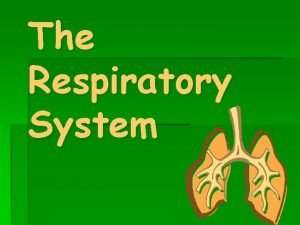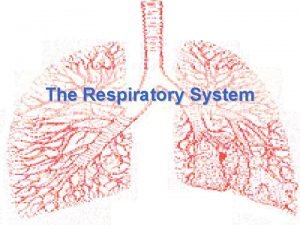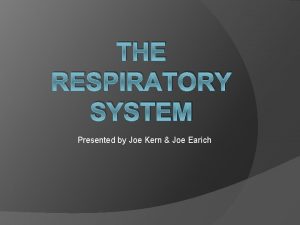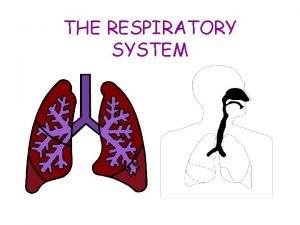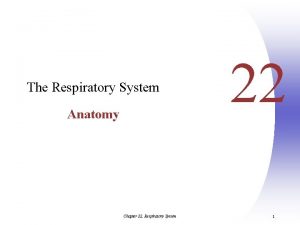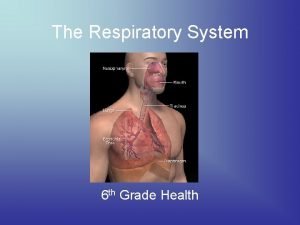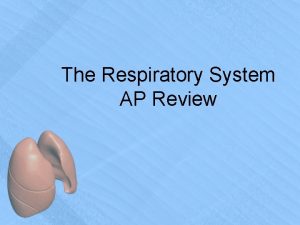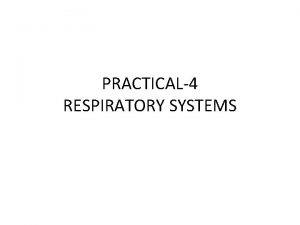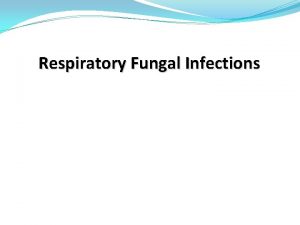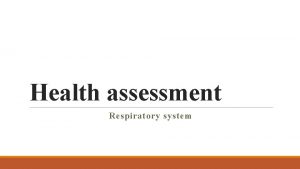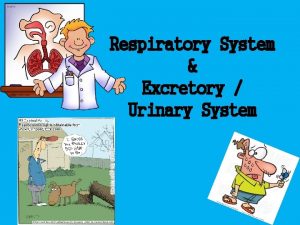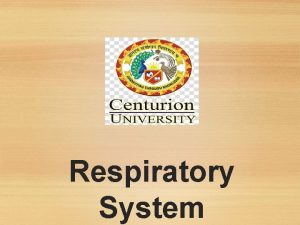The Respiratory System 6 th Grade Health Learning




















- Slides: 20

The Respiratory System 6 th Grade Health

Learning Target: I will learn about the Respiratory System. Success Criteria: To be successful I will know: • The main parts of the Respiratory System, the importance of each and be able to list/label them. • What the two main jobs of the system are.

The Respiratory System What does it do? Two Main Jobs: • To pass oxygen from the air to the blood. • To remove gaseous waste from the body.

So what is in the air we breathe? Inhaled Air • 20. 9% Oxygen • 79. 0% Nitrogen • 0. 07% Carbon Dioxide • 0. 03% Other Gases Exhaled Air • 16. 3% Oxygen • 79. 0% Nitrogen • 4. 50% Carbon Dioxide • 0. 20% Other Gases

The parts of the system… 1. Nasal passage: where you take in air 2. Pharynx: connects your mouth and nasal passage 3. Epiglottis: flap of cartilage behind your tongue that helps close the opening to your windpipe when you swallow 4. Larynx: made of muscle and cartilage and where your vocal cords are located 5. Trachea: tube that serves as the main passageway for the air to and from the lungs

Continued… 6. Alveoli: tiny air sacs at the end of the bronchioles 7. Bronchi: tubes that continue to clean the air that you breathe in on the way to the lungs 8. Diaphragm: large sheet of muscle separating the chest cavity from the lower part of your body that contracts and relaxes as you breathe in and out 9. Lungs: absorb the oxygen from the air you breathe

The lungs take up a large portion of the chest cavity from the collarbone down to the diaphragm.

The right lung is divided into three sections, or lobes. The left lung is slightly smaller to make room for the heart and has only two lobes.

The two branches of the trachea, called bronchi, subdivide within the lobes into smaller and smaller air vessels known as bronchioles. Bronchioles end in alveoli, tiny air sacs surrounded by capillaries.

When the alveoli inflate with inhaled air, oxygen goes into the blood in the capillaries to be pumped by the heart to the tissues of the body. At the same time carbon dioxide diffuses out of the blood into the lungs, where it is exhaled.

Alveoli A scanning electron micrograph shows the tiny sacs known as alveoli within a section of human lung tissue. Human beings have a thin layer of about 600 million alveoli within their lungs. This layer helps with the exchanging of oxygen and carbon dioxide with the surrounding blood capillaries.

Why do you need to breathe? • All the cells in your body require oxygen. • Without oxygen, cells couldn't move, build, reproduce, or turn food into energy. • Cells would die without oxygen and therefore you would not be able to survive.

So, it all starts at the nose? v You breathe in about 20 times a minute. v You inhale air and pass it through your nasal passages where the air is filtered, heated, moistened and enters the back of the throat. v The esophagus or foodpipe is located at the back of the throat and the windpipe for air is located at the front. v When we eat, a flap -- the epiglottis -- flops down to cover the windpipe so that food doesn't go down the windpipe.

How do you breathe? 1. You breathe with the help of your diaphragm and other muscles in your chest and abdomen. 2. When your diaphragm pulls down, it leaves more space for the lungs to expand. 3. The air then expands your lungs like a pair of balloons. 4. When your diaphragm relaxes, the cavity inside your body gets smaller again. 5. Your muscles squeeze your rib cage and your lungs begin to collapse as the air is pushed up and out your body in an exhale.

Diaphragm and Respiration 1. As the diaphragm contracts and moves downward, muscles pull the rib cage outward. 2. The chest cavity expands, and air rushes into the lungs through the trachea. 3. When the diaphragm relaxes to its normal, upwardly curving position, the lungs contract, and air is forced out.

Diaphragm and Respiration

Interesting Facts… • Your lungs contain almost 1500 miles of airways and over 300 million alveoli. • Every minute you breathe in 13 pints of air. • Plants are our partners in breathing. We breathe in air, use the oxygen in it, and release carbon dioxide. Plants take in carbon dioxide and release oxygen. • People tend to get more colds in the winter because we're indoors more often and in close proximity to other people. When people sneeze, cough and even breathe -- germs go flying!

Continued… • If your nose is at its best, you can tell the difference between 4000 -10, 000 smells. • As you grow older, your sense of smell gets worse. Children are more likely to notice more subtle smells than parents or grandparents. • Bloodhounds smell at least 1000 times better than humans.

Fun Facts Continued…Why do we hiccup? ?

Respiratory System… To sum it all up watch this respiratory system video…click on the link below! http: //www. kidshealth. org/kid/htbw/_bfs_RSmoviesource. html
 Respiratory zone and conducting zone
Respiratory zone and conducting zone Digestive system respiratory system and circulatory system
Digestive system respiratory system and circulatory system Respiratory system learning objectives
Respiratory system learning objectives Learning objectives of respiratory system
Learning objectives of respiratory system Tiny air sacs at the end of the bronchioles
Tiny air sacs at the end of the bronchioles Circulatory system and respiratory system work together
Circulatory system and respiratory system work together Cuadro comparativo entre e-learning b-learning y m-learning
Cuadro comparativo entre e-learning b-learning y m-learning Alternative learning system learning strands
Alternative learning system learning strands Bozeman respiratory system
Bozeman respiratory system Unit 9 respiratory system
Unit 9 respiratory system Diagnostic test of respiratory system
Diagnostic test of respiratory system What is the respiratory system
What is the respiratory system Membranes and ligaments of larynx
Membranes and ligaments of larynx Respiratory system coloring page
Respiratory system coloring page Respiratory system purpose
Respiratory system purpose Conclusion on respiratory system
Conclusion on respiratory system Jobs of the respiratory system
Jobs of the respiratory system Chapter 7 cengage
Chapter 7 cengage Bronchide
Bronchide Respiratory system
Respiratory system Interesting facts about respiratory system
Interesting facts about respiratory system


